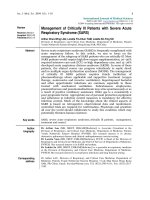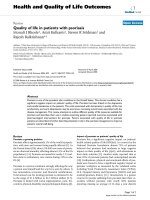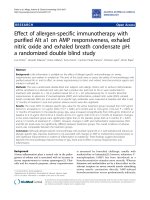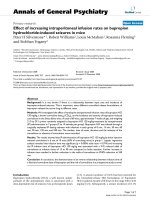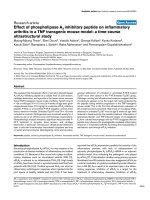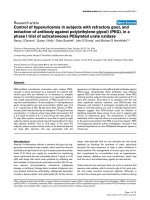Báo cáo y học: "Effect of duloxetine in patients with fibromyalgia: tiredness subgroups" pptx
Bạn đang xem bản rút gọn của tài liệu. Xem và tải ngay bản đầy đủ của tài liệu tại đây (335.36 KB, 8 trang )
RESEARCH ARTICLE Open Access
Effect of duloxetine in patients with fibromyalgia:
tiredness subgroups
Laurence A Bradley
1
, Robert Bennett
2
, Irwin J Russell
3
, Madelaine M Wohlreich
4*
, Amy S Chappell
5,6
, Fujun Wang
7
,
Deborah N D’Souza
8
, Harvey Moldofsky
9
Abstract
Introduction: This study tested the hypothesis that baseline ratings of fatigue/tiredness would be negatively
associated with the efficacy of duloxetine on measures of pain and functional ability in patients with fibromyalgia.
Methods: A post hoc analysis of pooled data from 4 double-blind, placebo-controlled studies of duloxetine in
fibromyalgia was performed. The fibromyalgia impact questionnaire (FIQ) tiredness item score (0 to 10 scale) was
used to define tiredness subgroups. Patients were stratified into 3 subgroups: mild (0 to 3), moderate (4 to 6), and
severe (7 to 10) tiredness. Analysis of covariance models and logistic regressions were used to test treatment-by-
tiredness subgroup interactions.
Results: Data from the first 3 months are included in this post hoc analysis (duloxetine N = 797, placebo N = 535).
At baseline, the distribution of tiredness severity in the duloxetine and placebo groups respectively was 3.64% and
3.75% mild, 16.71% and 15.57% moderate, and 79.65% and 80.68% severe. Rates of clinically significant (≥30% and
≥50%) improvement in brief pain inventory (BPI) average pain were similar across the tiredness subgroups.
Tiredness severity at baseline was not negatively associated with the effects of duloxetine on patients’ reports of
functional ability using the FIQ total score, FIQ measures of physical impairment, interference with work, pain,
stiffness, and depression and the medical outcomes study short form-36 (SF-36).
Conclusions: Studies of duloxetine in fibromyalgia have demonstrated clinically significant improvements in pain
and functional ability (FIQ, SF-36). This post hoc analysis of data shows that the efficacy of duloxetine among
patients with fibromyalgia does not vary as a function of baseline ratings of fatigue/tiredness.
Introduction
Fibromyalgia is a disorder that is found in approximately
2% of the general population and is characterized by
chronic widespread pain and tenderness [1]. Additional
symptoms that often accompany fibromyalgia are tired-
ness or fatigue, depressed mood, sleep disturbance, and
headache [2,3]. We will use the term ‘tiredness ’ through-
out this report, due to our decision to use the fibro-
myalgia impact questionnaire (FIQ) outcome measure,
unless we refer specifically to studies that have used
measures of ‘fatigue’.
Duloxetine, a potent reuptake inhibitor of ser otonin
and norepinephrine, wa s approved in the USA for the
management of fibromyalgia in June 2008. Preclinical
models of central sensitization suggest that duloxetine is
efficacious in the treatment of patients w ith persistent/
chronic pain. In rodents, duloxetine has demonstrated
efficacy in the formalin and capsaicin models of persis-
tent pain, as well as in the partial sciatic nerve ligation
and L5/L6 spinal nerve ligation models of neuropathic
pain [4,5]. Duloxetine is efficacious in the treatment of
the painful physical symptoms associated with depres-
sion and the pain associated with diabetic neuropathy in
nondepressed patients [6,7]. The results of four placebo-
controlled clinical trials of duloxetine in the treatment
of fibromyalgia have been previously reported [8-11].
Patients with fibromyalgia frequently report moderate
to severe fatigue and the prevalence of fatigue in
patients with fibromyalgia (76%) is almost double that of
patients with osteoarthritis or rheumatoid arthritis (41%)
[12,13]. An evidence-based review of the literature on
chronic pain found a highly consistent association
* Correspondence:
4
Lilly Research Laboratories, Lilly Corporate Center, Indianapolis, IN 46285,
USA
Bradley et al. Arthritis Research & Therapy 2010, 12:R141
/>© 2010 Brad ley et al.; licensee BioMed Central Ltd . This is an open access article distributed under the terms of the Creative Commons
Attribu tion License (h ttp://creativecommons.org/licenses/by/2.0), which permits unrestr icted use, distribution, and reproduction in
any medium, provided the original work is properly cite d.
between fatigue and pain in multiple studies and con-
cluded that this may represent an etiological relation
[14]. This conclusion was based in part on the results of
several studies showing that fatigue develops following
the onset of chronic pain and that severity of chronic
pain is positively associated with the likelihood of subse-
quent reports of fatigue [15,16]. However, few studies
have assessed whether fatigue or tiredness levels are
associated with variations in the efficacy of pharmaco lo-
gic therapies for chronic pain.Thisisaparticularly
important issue in the management of patients with
fibromyalgia who often report relatively high levels of
fatigue/tiredness in addition to chronic widespread pain.
The present study analyzed data from four placebo-con-
trolled trials o f duloxetine in patients with fibromyalgia
to test the hypothesis t hat baseline ratings of tiredness
would be negatively associated with the efficacy of
duloxetine on measures of pain and functional ability in
patients with fibromyalgia.
Materials and methods
This study comprised a pooled analysis of four double-
blind, placebo-controlle d, randomized, multicenter clini-
cal trials of duloxetine in patients with fibromyalgia.
These studies were conducted in accordance with the
ethical principles that have their origin in the Declara-
tion of Helsinki and that are consistent with good clini-
cal practices and the applicable laws and regulations.
Table 1 shows the dosage, administration, and duration
of treatment for each of the studies. The details of these
studies have been reported previously [8-11] and are
summarized here. Male and femal e p atients were
entered into studies 1, 3, and 4, whereas study 2
included only female patients. Only three-month data
are included in the analyses presented here.
Included patients were at least 18 years of age and
met the criteria for fibromyalgia as defined by the
American College of Rheumatology. In study 1, patient s
were required to indicate a pain score of at least 4 on
the FIQ pain item (score range of 0 to 10, with 10 indi-
cating very severe pain) [17]. In studies 2 to 4, patients
were required to indicate a pain score of at least 4 on
the 24-hour average pain severity item of the brief pain
inventory (BPI) (score range of 0 to 10, with 10 indicat-
ing pain as bad as you can imagine) [18]. The major
exclusion criteria w ere serious or unstable medical or
psychiatric illness, current primary psychiatric diagnosis
other than major depressive disorder, a primary diagno-
sis of anxiety disorder in the past year, pain from trau-
matic injury, or rheumatologic illness [8-11].
All four studies assessed the effects of duloxetine
and placebo on the BPI average pain score, the FIQ
(a patient self-reported instrument that assesses the
impact of fibromyalgia symptoms and functional impair-
ment; the FIQ total score ranges fro m 0 (no impact) to
80 (maximum impact)), the patient global i mpressions
of improvement (PGI-Improvement, a patient-rated
global assessment of response to treatment with scores
ranging from 1 (very much better) to 7 (very much
worse)), and the medical outcomes study short form-36
(SF-36, a quality-of-life measure including eight health-
status domains that are each scored 0 to 100, with
higher scores indicating better health).
The raw scores for the F IQ tiredness item range from
0 to 10 [17]. In the analyses reported here, the FIQ
tiredness item is used to substitute for a formal measure
of fatigue (multidimensional fatigue inventory), because
the latter was not used in all the four fibromyalgia stu-
dies. Based on the FIQ tiredness item score (0 to 10) at
study entry, patients were stratified into three sub-
groups: mild (0 to 3), moderate (4 to 6), or severe (7 to
10) tiredness. Previous studies have also used an
11-point numeric rating scale for measuring fatigue,
such as the fatigue severity scale [19] and the brief fati-
gue i nventory where scores within the ranges of 0 to 3,
4to6,and7to10pointsindicatemild,moderate,and
severe fatigue levels, respectively [20].
Treatment-emergent adverse events (TEAEs), collected
at every visit by spontaneous reporting from the patient,
within the three subgroups were also evaluated. A TEAE
was any reported event that first occurred or worsened
in severity during treatment, compared with the prede-
fined baseline period.
Statistical methods
All randomized patients (except study 3 patients on the
suboptimal dose of 20 mg once daily (n = 79) with at
Table 1 Summary of placebo-controlled trials of
duloxetine for the treatment of fibromyalgia
Study Treatment
duration
a
(weeks)
Placebo
(n)
Dosage Duloxetine
(n)
Arnold and
colleagues 2004 [8]
12 103 60 mg
BID
104
Arnold and
colleagues 2005 [9]
12 120 60 mg
QD
118
60 mg
BID
116
20 mg
QD
79
Russell and
colleagues 2008 [11]
28 144 60 mg
QD
150
120 mg
QD
147
Chappell and
colleagues 2008 [10]
28 168 60/120
mg QD
162
a
Three-month data are included in the analyses presented. BID, twice daily;
QD, once daily.
Bradley et al. Arthritis Research & Therapy 2010, 12:R141
/>Page 2 of 8
least one nonmissing postbaseline assessment w ere
included in the efficacy analyses.
Changes from baseline to endpoint for continuous
efficacy measures were analyzed using an analysis of
covariance model, with missing values imputed using
the last-observation-carried-forward approach. The
model included baseline, treatment, study, tiredness sub-
group, and treatment-by-tiredness subgroup interaction.
The baseline characteristics were analyzed using the
Cochran-Mantel-Haenszel test controlling for study, or
analysis of variance, which included treatment and
study.
Categorical outcomes were analyzed using logistic
regression (including terms for study, treatment, tired-
ness subgroup, and treatment-by-tiredness subgroup
interaction) or Fisher’ s exact test. Treatment effects
were tested at a two-sided significance level of 0.05.
Interaction effects were tested at a two-sided signifi-
cance level of 0.1. The term ‘significant’ indicates statis-
tical significance throughout the manuscript.
Results
Demographics
Across all studies, 797 patients received duloxetine and
535 patients received placebo for approximately three
months. There were no significant differences between
duloxetine-treated and placebo-treated patients in any of
the patients’ demographic variables. The mean age of
patients was 50.2 years (standard deviation = 11.0, range
19 to 83 years); the majority of patients were female
(n = 1262, 94.7%) and Caucasian (n = 1169, 87.8%).
Distribution of tiredness subgroups
At baseline, the distribution of t iredness severity in the
duloxetin e group (based on the FIQ tiredness item score)
was 3.64% (n = 29) mild (0 to 3), 16.71% (n = 133) mod-
erate (4 to 6), and 79.65% (n = 634) severe (7 to 10); the
distributio n in the p lacebo group was 3.75% (n = 20)
mild, 15.57% (n = 83) moderate, and 80.68% (n = 430)
severe. Within the duloxetine and placebo groups, the
mean baseline FIQ tiredness scores in the mild subgroup
were 2.5 and 2.7, respectively, in the moderate subgroup
was 5.3 (duloxetine and placebo), and in the severe
subgroup were 8.6 and 8.7, respectively.
Efficacy measures by tiredness subgroups
Brief pain inventory
Within the severe subgroup, there was a significant
difference between the duloxetine and placebo groups
(P < 0.001) in the number of patients with 30% or
greater and 50% or greater reductions in the BPI average
pain response (Figure 1). For the BPI average pain score,
within the severe subgroup there was a significant differ-
ence (P < 0.001) in the mean change from baseline to
endpoint between the duloxetine and placebo groups
(Table 2).
Fibromyalgia impact questionnaire
For the FIQ pain score, within the severe subgroup there
was a significant difference (P < 0.001) in the mean
change (standard error (SE)) from baseline to endpoint
between the duloxetine (-2.1 (0.1)) and placebo (-1.4
(0.1)) groups (Table 2). Within the severe subgroup,
there were also significant differences in the mean change
from baseline to endpoint between the duloxetine and
placebo groups for the FIQ total score, physical impair-
ment score, interference with work,stiffness,anxious,
and depression scores. For the FIQ tiredness score, there
was no significant difference in the mean change (SE)
from baseline to endpoint between the duloxetine and
placebo groups, within any of the tiredness subgroups
(mil d 2.4 (0.7) (duloxetine), 1.6 (0.8) (placebo), moderate
-0.2 (0.2) (duloxetine), 0.1 (0.3) (placebo), and severe
-1.8 (0.1) (duloxetine), -1.6 (0.1) (placebo)). Other FIQ
measures are also reported in Table 2.
The number o f patients with 30% improvement in
tiredness at endpoint was 257 (33.9%) in the duloxetine
group and 150 (29.0%) in the placebo group (P = 0.067).
The number of patients with 50% improvement in tired-
ness at endpoint was 173 (22.8%) in the duloxetine group
and 93 (18.0%) in the placebo group (P =0.042).Nosig-
nificant differences were observed between the duloxe-
tine and p lacebo groups in the number of patients with
30% worsening in tiredness at endpoint (duloxetine,
n = 62 (8.2%), placebo, n = 41 (7.9%); P = 0.917) or in the
number of patients with 50% worsening in tiredness at
endpoint (duloxetine, n = 46 (6.1%), placebo, n = 27
(5.2%); P = 0.542).
Patient global impressions of improvement
We found differences between the duloxetine-treated
and placebo-treated patients in the frequencies of PGI-
Improvement scores of 1 or 2 (patients feeling very
much better or much better) across t wo of the three
tiredness subgroups. There were significantly g reater
numbers of patients in the duloxetine, compared with
the control group, who reported global posit ive
improvements in both the severe tiredness subgroup
(duloxetine, n = 233 (38.26%); placebo, n = 87 (21.07%);
P < 0.001), and moderate tiredness subgroup (duloxe-
tine, n = 45 (35.71%); placebo, n = 18 (21.95%);
P = 0.044). This di fference was not found i n the mild
tiredness subgroup (duloxetine, n = 15 (53.57%),
placebo, n = 7 (36.84%); P = 0.373).
Medical outcomes study short form-36
Within the severe subgroup, there was a significant dif-
ference (P < 0.05) in the mean change of the SF-36
scores from baseline to endpoint between the duloxetine
and placebo groups on the health outcome measures of
the SF-36 mental component summary; bodily pain,
Bradley et al. Arthritis Research & Therapy 2010, 12:R141
/>Page 3 of 8
general health, mental health, physical functioning, role-
emotional, role-physical, social functioning, and vitality
(Table 2).
Treatment-by-tiredness subgroup interaction
The effect of duloxetine on the BPI average pain score was
consiste nt across patients wi th mild, moderate, or severe
tiredness (P > 0.1 for treatment-by-tiredness subgroup
interaction). For the FIQ pain score, there was no signifi-
cant therapy-by-tiredness subgroup interaction (P = 0.74).
The effect of duloxetine on the FIQ total score, physical
impairment score, i nterference with work score, pain
score, tiredness score, rested score, stiffness score, and
depression score was consistent across patients with mild,
moderate, or severe tiredness (P > 0.1 f or treatment-by-
tiredness subgroup interaction). No significant therapy-by-
tiredness subgroup interaction in the PGI-Improvement
score was observed among the three tiredness subgroups
(P = 0.908). The effects of duloxetine on the health out-
come measures of the SF-36 mental component summary,
physical component summary, bodily pain, general health,
mental health, physical functioning, role-emotional, role-
physical, social functioning, and vitality were consistent
across patients with mild, moderate, or severe tiredness
(P > 0.1 for treatment-by-tiredness subgroup interaction).
Treatment-emergent adverse events
A significant (P < 0.1) tre atment-by-tiredness interaction
in the percentage of patien ts with one TEAE or more
was observed. Significant treatment-by-tire dness inter ac-
tions were found for the percentage of patients with the
following TEAEs: hypoaesthesia, arthralgia, cough, myal-
gia, bronchitis, influenza, palpitations, restless leg syn-
drome, and osteoarthritis (Table 3). Nausea was the most
common TEAE, with an o ccurrence of 28% (duloxetine)
and 15% (placebo) in the mild subgroup, 29% (duloxe-
tine) and 15% (placebo) in the moderate s ubgroup, and
30%(duloxetine)and11%(placebo)inthesevere
subgroup.However,therewasnosignificanttreatment-
by-tiredness subgroup interaction (P > 0.1) in the percen-
tage of patients with nausea. Comprehensive pooled
safety analyses for these four studies have been
performed and previously reported [21].
Discussion
Inapreviouslyconductedpooled analysis of these same
four randomized, doub le-blind, placebo-controlled trials
in patients with fibromyalgia, almost half (47.7%) of the
patients treated with duloxetine h ad a 30% or greater
reduction in BPI average pain, and 35.3% of patients had
a 50% or greater reduction in pain [22]. Among placebo-
treated patien ts, 32.1% had a 30% or greater reducti on in
BPI aver age pain, and 22.2% had a 50% or greater reduc-
tion [22]. A previous pooled analysis of these four clinical
trials [22] demonstrated that a significantly greater pro-
portion of patients treated with duloxetine versus placebo
reported feeling very much better or much better. More
than one third (38.4%) of duloxetine-treated patients
Figure 1 Brief pain inventory response. Proportions of patients with (a) 30% and (b) 50% reduction in the average brief pain inventory score.
***P < 0.001 vs. placebo. With both of the outcome measures, between-groups (duloxetine-treated vs. placebo-treated) analysis showed that the
group of patients receiving duloxetine exhibited significantly greater numbers of responding patients than among those receiving placebo, but
this was only true among the patients in the more severe tiredness group. There was no significant treatment-by-tiredness subgroup interaction
between the three subgroups (P > 0.1).
Bradley et al. Arthritis Research & Therapy 2010, 12:R141
/>Page 4 of 8
Table 2 Efficacy and functional outcome measures
Mild subgroup Moderate subgroup Severe subgroup
Placebo Duloxetine Placebo Duloxetine Placebo Duloxetine
BL
Mean
(SD)
Change
Mean
(SE)
BL
Mean
(SD)
Change
Mean
(SE)
BL
Mean
(SD)
Change
Mean
(SE)
BL
Mean
(SD)
Change
Mean
(SE)
BL
Mean
(SD)
Change
Mean
(SE)
BL
Mean
(SD)
Change
Mean (SE)
BPI average
Pain score
4.5 (1.3) -1.8 (0.6) 5.6 (1.7) -1.3 (0.5) 5.5 (1.3) -1.1 (0.2) 5.5 (1.4) -1.6 (0.2) 6.7 (1.5) -1.1 (0.1) 6.6 (1.5) -2.0 (0.1)***
FIQ
Total score 27.3 (11.4) -1.0 (4.2) 26.4
(7.6)
1.0 (3.5) 40.1
(8.8)
-4.4 (1.7) 39.3
(9.6)
-7.7 (1.3) 54.9
(9.9)
-9.4 (0.8) 54.4
(10.8)
-14.4 (0.7)***
Physical
Impairment
score
1.8 (1.8) -0.3 (0.6) 2.5 (1.9) 0.1 (0.5) 3.3 (2.0) -0.2 (0.2) 3.2 (2.2) -0.6 (0.2) 4.7 (2.1) -0.4 (0.1) 4.8 (2.3) -0.8 (0.1)*
Interference
with work
3.0 (2.2) -0.6 (0.7) 3.4 (2.2) -0.0 (0.5) 5.0 (1.7) -0.9 (0.3) 4.8 (2.3) -1.3 (0.2) 6.9 (1.9) -1.2 (0.1) 6.8 (2.2) -2.0 (0.1)***
Pain 4.1 (2.4) -0.7 (0.7) 5.2 (2.4) -1.0 (0.6) 6.0 (1.6) -0.9 (0.3) 6.2 (1.7) -1.5 (0.2) 7.6 (1.7) -1.4 (0.1) 7.5 (1.7) -2.1 (0.1)***
Tiredness 2.7 (0.6) 1.6 (0.8) 2.5 (0.7) 2.4 (0.7) 5.3 (0.8) 0.1 (0.3) 5.3 (0.8) -0.2 (0.2) 8.7 (1.1) -1.6 (0.1) 8.6 (1.1) -1.8 (0.1)
Rested 3.5 (2.0) 0.8 (0.7) 3.9 (1.7) 0.7 (0.6) 6.4 (1.9) -0.9 (0.3) 6.3 (2.1) -1.0 (0.3) 8.4 (1.6) -1.5 (0.1) 8.4 (1.7) -1.8 (0.1)
Stiffness 4.4 (2.4) 0.7 (0.7) 5.2 (2.6) -1.5 (0.5) 6.5 (2.0) -1.4 (0.3) 6.6 (2.0) -1.8 (0.2) 8.1 (1.7) -1.6 (0.1) 8.0 (1.7) -2.5 (0.1)***
Anxious
a
2.7 (2.8) -0.1 (0.6) 1.4 (1.9) 0.3 (0.5) 3.7 (2.3) -0.6 (0.3) 3.1 (2.6) -0.8 (0.2) 5.2 (3.0) -0.8 (0.1) 5.0 (3.2) -1.8 (0.1)***
Depression 1.2 (1.4) 0.2 (0.5) 1.3 (1.8) 0.2 (0.4) 2.5 (2.4) -0.2 (0.2) 2.4 (2.5) -0.8 (0.2)
*
4.5 (3.0) -0.5 (0.1) 4.4 (3.2) -1.6 (0.1)***
SF-36
Mental
component
summary
55.2 (7.7) -0.9 (2.4) 52.9
(8.0)
0.3 (2.0) 49.2
(10.3)
-0.1 (1.0) 51.1
(10.5)
1.6 (0.8) 42.7
(11.1)
2.0 (0.5) 42.8
(11.8)
5.4 (0.5)***
Physical
component
summary
33.8 (6.2) 3.8 (2.0) 33.9
(9.3)
2.8 (1.7) 31.6
(7.6)
2.5 (0.9) 31.2
(8.3)
4.2 (0.8) 27.6
(7.4)
3.1 (0.4) 27.8
(7.6)
4.1 (0.4)
Bodily pain 42.7 (8.4) 6.9 (4.8) 41.1
(17.8)
15.7
(3.9)
37.7
(13.2)
6.2 (2.1) 36.7
(12.2)
12.3
(1.7)*
27.8
(13.6)
8.6 (0.9) 28.4
(13.6)
14.2 (0.8)***
General health 60.1 (14.7) 3.5 (2.6) 58.9
(20.1)
6.9 (2.1) 53.3
(21.1)
0.7 (1.7) 53.9
(19.8)
4.1 (1.4) 41.8
(20.0)
5.1 (0.8) 44.0
(21.0)
7.7 (0.7)*
Mental health 75.3 (16.5) 1.3 (3.5) 77.2
(13.5)
3.5 (2.8) 69.5
(17.4)
1.8 (1.7) 72.6
(17.0)
4.6 (1.4) 60.9
(19.2)
3.3 (0.9) 61.2
(20.8)
9.9 (0.7)***
Physical
functioning
53.1 (19.1) 9.4 (4.4) 57.2
(21.6)
8.0 (3.5) 51.3
(21.2)
6.9 (2.1) 48.9
(20.4)
8.0 (1.7) 40.2
(21.1)
5.7 (0.9) 39.4
(21.8)
9.5 (0.8)**
Role-
emotional
88.9 (28.0) -2.4 (8.4) 75.6
(37.2)
-1.5 (6.9) 69.3
(39.0)
1.1 (4.0) 71.8
(37.0)
4.7 (3.2) 50.0
(42.6)
5.5 (2.0) 48.4
(43.8)
16.1 (1.7)***
Role-physical 44.4 (34.9) 6.1 (8.8) 37.5
(41.4)
-6.8 (7.2) 25.0
(34.1)
5.7 (4.2) 30.6
(36.9)
12.7
(3.4)
13.0
(23.1)
8.7
(1.7) 12.5
(23.6)
13.6 (1.4)*
Social
functioning
79.2 (23.1) 3.8 (4.7) 77.3
(19.6)
0.0 (3.8) 68.0
(22.5)
4.0 (2.2) 69.6
(25.0)
7.4 (1.7) 51.0
(23.3)
7.6 (1.1) 52.3
(24.8)
11.3 (1.0)*
Vitality 48.8 (16.8) 4.1 (5.2) 42.5
(20.0)
1.9 (4.2) 34.2
(17.0)
-0.3 (2.2) 38.5
(18.6)
5.6 (1.8)
*
19.3
(15.7)
6.9 (1.1) 20.3
(17.3)
11.7 (0.9)***
*P < 0.05 vs. placebo; **P < 0.01 vs. placebo; ***P < 0.001 vs. placebo;
a
P ≤ 0.1 therapy-by-fatigue subgroup interaction.
BL, baseline; SD, standard deviation; SE, standard error; BPI, brief pain inventory; FIQ, fibromyalgia impact questionnaire; SF-36, Medical Outcomes Study Short
Form-36.
Bradley et al. Arthritis Research & Therapy 2010, 12:R141
/>Page 5 of 8
reported feeling much better and less than one quarter
(21.7%) of the placebo-treated patients reported feeling
much better, based on PGI-Improvement scores.
Several double-blind, placebo-controlled studies ha ve
shown that duloxetine, compared with placebo, more fre-
quently produces clinically-significant improvements in
pain and functional ability [8-11]. A pooled analysis of
these studies showed that duloxetine was statistically
superior to placebo with respe ct to improv ement on FIQ
total scores and all SF-36 domains [22]. Furthermore, the
pooled data indicated that those patients who achieve
50% or greater improveme nt in tiredness were more
likely to have received duloxetine than placebo [22].
In the pooled analysis of four placebo -contro lled trials
in patients with fibromyalgia reported here, the efficacy
of duloxetine did not vary as a function of baseline rat-
ings of tiredness, as defined by the FIQ tiredness rating.
At baseline, the distribution of tiredness severity in the
duloxetine and placebo groups were less than 4% of
patients in the mild subgroup and more than 90% of
total patients in the moderate to severe subgroups. This
is not surprising, as a previous study has reported that
up to 90% of patients with fibromyalgia report moderate
to severe fatigue levels [12].
The rates of clinically significant (≥30% and ≥50%)
improvement in BPI average pain were similar across
the three tiredness subgroups, demonstrating that the
efficacy of duloxetine in the treatment of pain in
patients with fibromyalgia is not associated with baseline
tiredness levels.
Analyses of the PGI-Improvement produced findings
similar to t hose for BPI average pain ratings. As with
the other efficacy measures reported here, there was no
significant therapy-by-tiredness subgroup inter action on
themeasureofPGI-Improvement. Baseline tiredness
levels were not significantly associated with the effects
of duloxetine on the patients’ reports of functional abil-
ity using the F IQ total score and the FIQ measures of
physical impairment, interference with work, pain, stiff-
ness, depression and the SF-36 mental and physical
component summary scores, bodily pain, general health,
mental health, physical functioning, role-emotional,
role-physical, social functioning, and vitality.
Some limitations of this work should be c onsidered.
The results are based on four acute treatment trials of
12 weeks and the results may not generalize to a longer
duration of treatment. In addition, sleep and fatigue/
tiredness may have a correlation. Future studies should
measure sleep quality and its effect on fatigue/tiredness
in the fibromyalgia population. The results of thes e stu-
dies may not generalize to indi viduals with fibromyalgia
symptoms diagnosed with Diagnostic and Statistical
Manual of Mental Disorders-IV axis-one psychiatric dis-
order, rheumatic disease, or treatment-resistant patients,
because such patients were excluded from the studies.
Most of the patients included in these studies were mid-
dle-aged Caucasian women, which may limit generali za-
tion of these results to men and other individuals with
fibromyalgia. The FIQ tiredness item is used to substi-
tute the formal measure of fatigue, because the formal
fatiguemeasurewasnotusedinallfourofthefibro-
myalgia studies. The FIQ tiredness item may not cap-
ture all aspects of fatigue as a formal fatigue scale
would. It is worth noting t hat question number 20 of
the Beck depression inventory refers to fatigue and
tiredness interchangeably. Lastly, the distribution of
patients in the tiredness subgroups was skewed due to
the large number of patients in the severe subgroup (up
to 81%) compared with the moderate (up to 17%) and
the mild (<4%) subgroups; therefore, the information on
patients in the mild and moderate subgroups may not
be as robust as that in the severe subgroup.
Table 3 Treatment-emergent adverse events (%) with significant treatment-by-tiredness subgroup interaction
P-value (treatment-by-tiredness subgroup) Mild subgroup Moderate subgroup Severe subgroup
Placebo
(n = 20)
(%)
Duloxetine
(n = 29)
(%)
Placebo
(n = 83)
(%)
Duloxetine
(n = 133)
(%)
Placebo
(n = 430)
(%)
Duloxetine
(n = 634)
(%)
Patients with ≥1 TEAE 0.040 90.0 96.6 73.5 91.0 77.7 82.0
Hypoaesthesia 0.094 10.0 0.0 1.2 1.5 1.2 2.1
Arthralgia 0.008 10.0 0.0 9.6 2.3 2.8 3.8
Cough 0.034 15.0 0.0 1.2 3.0 2.6 3.2
Myalgia 0.081 10.0 3.5 0.0 3.8 1.6 3.3
Bronchitis 0.014 5.0 0.0 3.6 0.0 2.3 3.3
Influenza 0.019 0.0 3.5 6.0 0.8 1.4 2.5
Palpitations 0.085 0.0 3.5 4.8 1.5 2.5 1.2
Restless leg syndrome 0.030 5.0 0.0 0.0 3.0 1.4 0.6
Osteoarthritis 0.029 10.0 0.0 3.6 0.0 0.7 0.8
TEAE, treatment-emergent adverse event.
Bradley et al. Arthritis Research & Therapy 2010, 12:R141
/>Page 6 of 8
Conclusions
This pooled analysis of four randomized placebo-con-
trolled studies provides evidence that the efficacy of
duloxetine on pain does not vary as a function of
patients’ baseline ratings of tiredness, thus implying that
baseline tiredness may not need to be factored into
models of efficacy regarding pain.
Abbreviations
BPI: brief pain inventory; FIQ: fibromyalgia impact questionnaire ; PGI-
Improvement: patient global impressions of improvement; SE: standard error;
SF-36: medical outcomes study short form-36; TEAE: treatment-em ergent
adverse events.
Acknowledgements
This work was sponsored by Eli Lilly and Company and Boehringer
Ingelheim GmbH.
Author details
1
Division of Clinical Immunology and Rheumatology, University of Alabama
at Birmingham, 177A Shelby Interdisciplinary Research Building, 1825
University Boulevard, Birmingham, Alabama 35294, USA.
2
Oregon Health &
Science University, 3455 SW US Veterans Hospital Road, Portland, OR 97239,
USA.
3
The University of Texas Health Science Center at San Antonio, 7703
Floyd Curl Drive, San Antonio, TX 78229, USA.
4
Lilly Research Laboratories,
Lilly Corporate Center, Indianapolis, IN 46285, USA.
5
Medical, Neuroscience,
Lilly Research Laboratories, Lilly Corporate Center, Indianapolis, IN 46285,
USA.
6
IU The Indiana University Medical Center, Department of Neurology,
545 Barnhill Drive, Indianapolis, IN 46202, USA.
7
Statistics, Neuroscience, Lilly
Research Laboratories, Lilly Corporate Center, Indianapolis, IN 46285, USA.
8
Scientific Communications, Lilly Research Laboratories, Lilly Corporate
Center, Indianapolis, IN 46285, USA.
9
The Toronto Psychiatric Research
Foundation, 951 Wilson Avenue, Toronto, Ontario, M3K 2S7, Canada.
Authors’ contributions
Each of the authors listed have made substantive intellectual contributions
to this study. LB, RB, IJR, MMW, ASC, FW, DND, and HM have made
substantial contributions to analysis and interpretation of data, have been
involved in drafting the manuscript and/or revising it critically for important
intellectual content and have given final approval of the version to be
published.
Competing interests
Dr Bradley is a consultant for Eli Lilly, Pfizer, and Forest; has received grant/
research support from the National Institutes of Health, the Agency for
Healthcare Research and Quality, Eli Lilly, Pfizer, and the American
Fibromyalgia Syndrome Association; has received honoraria from Eli Lilly,
Pfizer, Forest, and the Society for Women’s Health Research; is a member of
the speakers/advisory board for Eli Lilly and Company; and has received
royalties from UpToDate Rheumatology. Dr Bennett is on advisory boards for
Eli Lilly and Company, Schwarz, Jazz and Pfizer. Dr. Russell has received
honorarium as a consultant and speaker for Pfizer, Eli Lilly and Company,
Jazz, Forest Laboratories, and Grunenthal, and as a consultant for Allergan.
He has received honorarium for being a speaker on the medical advisory
board for Pfizer, Eli Lilly and Company, Jazz, Pierre Fabre, Nicox, Daiichii
Sankyo, and Ortho McNeil Jannssen. He has received funding as a principal
investigator for Pfizer, as a local principal local investigator for Eli Lilly and
Company, Allergan, and Schwarz/UCB, and as a lead investigator for Jazz,
Grunenthal, and Autoimmune Technologies. Dr. Russell is the editor of the
Journal of Musculoskeletal Pain and receives from the publisher a royalty for
his work in that capacity. He is a member of the International MYOPAIN
Society Board (non-remunerative position). Dr. Russell has never owned a
pharmaceutical company, or owned stock in a pharmaceutical company that
he is aware of, or worked as an employee for a pharmaceutical company. Dr
Moldofsky is the principal investigator at a research site, the Toronto
Psychiatric Research Foundation, a not for profit corporation that has
received funds for participating in a research study, which is sponsored by
Eli Lilly and Company. Dr. Moldofsky has received research support from Eli
Lilly, Krele, Pfizer, Pierre Fabre, Sanofi Aventis, and Schering Plough; has
acted as a consultant for Boehringer Ingleheim, Eli Lilly, Jazz Pharmaceuticals,
Krele, Lundbeck, Merck, Paladin Labs, Pfizer, Pierre Fabre, Sanofi Aventis,
Schering Plough, and Valeant; and was on the speaker’s bureau for Pfizer.
Drs Wohlreich, Chappell, Wang, and D’Souza are employees and
stockholders of Eli Lilly and Company.
Received: 29 July 2009 Revised: 1 December 2009
Accepted: 14 July 2010 Published: 14 July 2010
References
1. Wolfe F, Ross K, Anderson J, Russell IJ, Hebert L: The prevalence and
characteristics of fibromyalgia in the general population. Arthritis Rheum
1995, 38:19-28.
2. Bennett RM, Jones J, Turk DC, Russell IJ, Matallana L: An internet survey of
2,596 people with fibromyalgia. BMC Musculoskelet Disord 2007, 8:27.
3. Wolfe F, Smythe HA, Yunus MB, Bennett RM, Bombardier C, Goldenberg DL,
Tugwell P, Campbell SM, Abeles M, Clark P, Fam AG, Farber SJ, Fiechtner JJ,
Franklin CM, Gatter RA, Hamaty D, Lessard J, Lichtbroun AS, Masi AT,
McCain GA, Reynolds WJ, Romano TJ, Russell IJ, Sheon RP: The American
College of Rheumatology 1990 criteria for the classification of
fibromyalgia. Report of the multicenter criteria committee. Arthritis
Rheum 1990, 33:160-172.
4. Seltzer Z, Dubner R, Shir Y: A novel behavioral model of neuropathic pain
disorders produced in rats by partial sciatic nerve injury. Pain 1990,
43:205-218.
5. Kim SH, Chung JM: An experimental model for peripheral neuropathy
produced by segmental spinal nerve ligation in the rat. Pain 1992,
50:355-363.
6. Goldstein DJ, Lu Y, Detke MJ, Hudson J, Iyengar S, Demitrack MA: Effects of
duloxetine on painful physical symptoms associated with depression.
Psychosomatics 2004, 45:17-28.
7. Goldstein DJ, Lu Y, Detke MJ, Lee TC, Iyengar S: Duloxetine vs. placebo in
patients with painful diabetic neuropathy. Pain 2005, 116:109-118.
8. Arnold LM, Lu Y, Crofford LJ, Wohlreich M, Detke MJ, Iyengar S,
Goldstein DJ: A double-blind, multicenter trial comparing duloxetine
with placebo in the treatment of fibromyalgia patients with or without
major depressive disorder. Arthritis Rheum 2004, 50:2974-2984.
9. Arnold LM, Rosen A, Pritchett YL, D’Souza DN, Goldstein DJ, Iyengar S,
Wernicke JF: A randomized, double-blind, placebo-controlled trial of
duloxetine in the treatment of women with fibromyalgia with or
without major depressive disorder. Pain 2005, 119:5-15.
10. Chappell AS, Bradley LA, Wiltse C, Detke MJ, D’Souza DN, Spaeth M: A six-
month double-blind, placebo-controlled, randomized clinical trial of
duloxetine for the treatment of fibromyalgia. Int J Gen Med 2009,
1:91-102.
11. Russell IJ, Mease PJ, Smith TR, Kajdasz DK, Wohlreich MM, Detke MJ,
Walker DJ, Chappell AS, Arnold LM: Efficacy and safety of duloxetine for
treatment of fibromyalgia in patients with or without major depressive
disorder: Results from a 6-month, randomized, double-blind, placebo-
controlled, fixed-dose trial. Pain 2008, 136:432-444.
12. Goldenberg DL, Simms RW, Geiger A, Komaroff AL: High frequency of
fibromyalgia in patients with chronic fatigue seen in a primary care
practice. Arthritis Rheum 1990, 33:381-387.
13. Wolfe F, Hawley DJ, Wilson K: The prevalence and meaning of fatigue in
rheumatic disease. J Rheumatol 1996, 23:1407-1417.
14. Fishbain DA, Cole B, Cutler RB, Lewis J, Rosomoff HL, Fosomoff RS: Is
pain
fatiguing? A structured evidence-based review. Pain Med 2003, 4:51-62.
15. Feuerstein M, Carter RL, Papciak AS: A prospective analysis of stress and
fatigue in recurrent low back pain. Pain 1987, 31:333-344.
16. Stone P, Richards M, A’Hern R, Hardy J: A study to investigate the
prevalence, severity and correlates of fatigue among patients with
cancer in comparison with a control group of volunteers without
cancer. Ann Oncol 2000, 11:561-567.
17. Burckhardt CS, Clark SR, Bennett RM: The fibromyalgia impact
questionnaire: development and validation. J Rheumatol 1991, 18:728-733.
18. Cleeland CS, Ryan KM: Pain assessment: global use of the Brief Pain
Inventory. Ann Acad Med Singapore 1994, 23:129-138.
Bradley et al. Arthritis Research & Therapy 2010, 12:R141
/>Page 7 of 8
19. Krupp LB, LaRocca NG, Muir-Nash J, Steinberg AD: The fatigue severity
scale. Application to patients with multiple sclerosis and systemic lupus
erythematosus. Arch Neurol 1989, 46:1121-1123.
20. Mendoza TR, Wang XS, Cleeland CS, Morrissey M, Johnson BA, Wendt JK,
Huber SL: The rapid assessment of fatigue severity in cancer patients:
use of the Brief Fatigue Inventory. Cancer 1999, 85:1186-1196.
21. Choy EH, Mease PJ, Kajdasz DK, Wohlreich MM, Crits-Christoph P, Walker DJ,
Chappell AS: Safety and tolerability of duloxetine in the treatment of
patients with fibromyalgia: pooled analysis of data from five clinical
trials. Clin Rheumatol 2009, 28:1035-1044.
22. Arnold LM, Clauw D, Wohlreich MM, Wang F, Ahl J, Gaynor PJ, Chappell AS:
Efficacy of duloxetine in patients with fibromyalgia: pooled analysis of
four placebo-controlled clinical trials. Prim Care Companion J Clin
Psychiatry 2009, 11:237-244.
doi:10.1186/ar3081
Cite this article as: Bradley et al.: Effect of duloxetine in patients with
fibromyalgia: tiredness subgroups. Arthritis Research & Therapy 2010 12:
R141.
Submit your next manuscript to BioMed Central
and take full advantage of:
• Convenient online submission
• Thorough peer review
• No space constraints or color figure charges
• Immediate publication on acceptance
• Inclusion in PubMed, CAS, Scopus and Google Scholar
• Research which is freely available for redistribution
Submit your manuscript at
www.biomedcentral.com/submit
Bradley et al. Arthritis Research & Therapy 2010, 12:R141
/>Page 8 of 8
